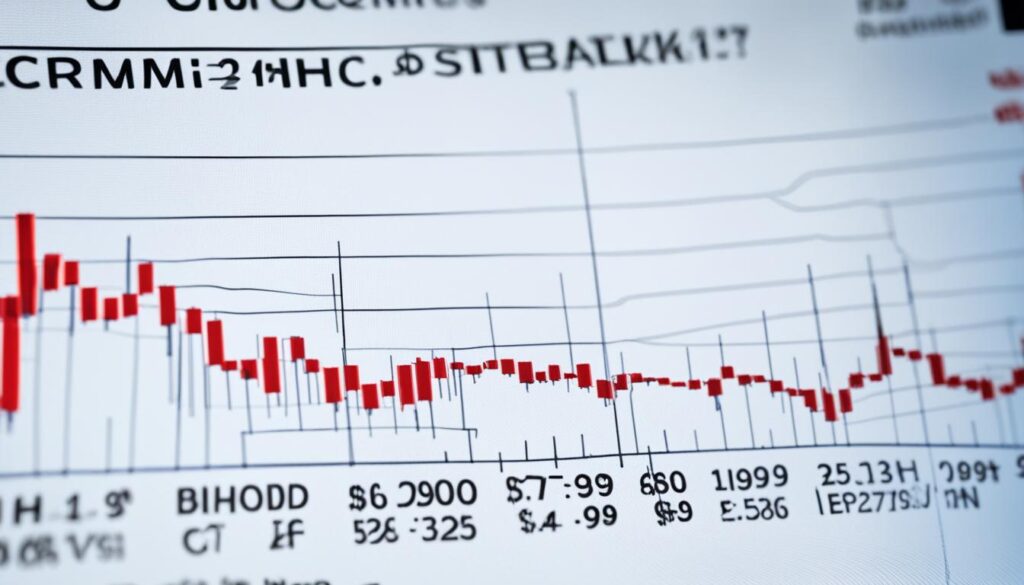Over $2.9 trillion was lost from major indices and stocks because of fears of a global recession. The S&P 500 fell by over 2% in one day, and the Nasdaq Composite dropped by 3%. We look into the reasons behind the recent crypto crash and its effects on Bitcoin and other major cryptocurrencies.
Key Takeaways
- The cryptocurrency market saw a big drop, with Bitcoin falling from $65,600 to $62,300. Ethereum also dropped 15.87% below the $3,000 level.
- The total value of the crypto market went down by 15% in the last week, from $2.442 trillion to $2.095 trillion. This shows how volatile the market is.
- Prominent Bitcoin figure Samson Mow said the traditional financial markets caused Bitcoin’s drop. He believes it’s a short-term event made worse by ETFs.
- The stock market also fell, with the Nasdaq Composite down by 2.43% and the Dow Jones Industrial Average losing 1.51%.
- Increased market liquidations, regulatory challenges, and worries about crypto mining’s energy use are adding to the crypto market’s downturn.
Understanding the Crypto Market Downturn
The recent cryptocurrency market crash shows how volatile and risky this market can be. Bitcoin, the top cryptocurrency, has lost more than half its value since November 2021. This drop led to the whole crypto market falling. In just a week, the market lost a huge $600 billion, with Bitcoin going below $30,000 for the first time since July 2021.
Factors Contributing to the Recent Crash
Several factors led to the crypto market downturn. The wait for the Federal Open Market Committee (FOMC) to cut rates, big withdrawals from Bitcoin ETFs (-$237.45M), and Bitcoin being sold by Mt. Gox to its creditors all played a part. This caused a big wave of selling, wiping out over $500 million in long positions.
Impact on Bitcoin and Other Major Cryptocurrencies
The crypto crash hit Bitcoin, Ethereum, and other altcoins hard. Ethereum’s Ether (ETH) and Bitcoin Cash’s BCH saw big drops too. The failure of Terra (LUNA) and TerraUSD (UST) showed the market-wide contagion and the need for better rules and transparency in the cryptocurrency market.
| Cryptocurrency | Current Price | All-Time High | Price Change from ATH |
|---|---|---|---|
| Bitcoin (BTC) | $18,000 | $69,000 | -73.91% |
| Ethereum (ETH) | $1,200 | $4,800 | -75% |
| Terra (LUNA) | $0.000000999967 | $119.18 | -99.99% |
| TerraUSD (UST) | $0.13 | $1 | -87% |

“The recent crypto market crash has been a stark reminder of the inherent volatility and risks associated with this emerging asset class.”
The Role of Traditional Financial Markets
The crypto market downturn is linked to traditional financial markets. The stock market lost over $2.9 trillion in one day, hinting at a global recession. The Federal Reserve’s decision to wait on interest rate cuts has raised worries about a worse economic downturn in the fourth quarter.
Early signs of recession, like McDonald’s first sales drop since 2020 and high inventory in consumer sectors, are showing up.
Correlation Between TradFi Markets and Crypto Prices
When traditional financial markets struggle, crypto prices take a hit too. Bitcoin, the top cryptocurrency, has hit a market value of over $1 trillion. The link between crypto and traditional markets is clear, with crypto reflecting stock market ups and downs.
The connection between traditional financial markets and the crypto world has grown stronger over time. By mid-2023, about 17 percent of U.S. adults had invested in, traded, or used cryptocurrency. This rise in crypto use has made the two markets more connected, as what happens in one can affect the other.
“The crypto market downturn is closely tied to the performance of traditional financial markets. The stock market has lost over $2.9 trillion in a single day, signaling fears of a global recession.”
A stock market crash or global recession can really hit the crypto market hard. By January 2024, 130 countries, including the United States, were looking into their own central bank digital currencies (CBDCs) to compete with crypto. This new regulatory scene and economic uncertainty can make the crypto market even more unstable.

WHY CRYPTO CRASH: Bitcoin The End ?
The recent downturn in the crypto market has left many wondering about Bitcoin and other digital currencies’ futures. Bitcoin has shown surprising stability, unlike other altcoins. Yet, the market’s overall volatility is expected to keep going. The Crypto Fear & Greed Index has hit 29, its lowest since early January 2023. This shows the most negative investor feelings since the 2022 crypto winter ended.
Despite the hurdles, Bitcoin is gaining support from institutions. Morgan Stanley now offers Bitcoin ETFs to its high-net-worth clients. But, the role of Bitcoin in the U.S. economy is still being closely watched. Concerns include bitcoin price fluctuations, digital currency regulation, and cryptocurrency adoption challenges.
| Statistic | Value |
|---|---|
| Bitcoin’s price drop from 2024 market top | 25%-30% |
| Major altcoins’ price drop from 2024 market top | Around 50% |
| German government’s Bitcoin holdings | $2.2 billion |
| U.S. government’s Bitcoin holdings | Over $12 billion |
| Mt. Gox estate’s Bitcoin holdings | Over $8 billion |
Some experts think Bitcoin’s price could drop to $50,000 due to current crypto skepticism and market conditions. If things don’t improve, ETF holders and miners might have to sell. But, a Federal Reserve interest rate cut in September could help the market. August and September are usually tough months for Bitcoin.
“The total market value of all cryptocurrencies currently exceeds $1.5 trillion, but nearly $1 trillion was wiped off the total value of cryptocurrencies in May.”
The debate on why crypto crash: bitcoin the end ? is ongoing. It’s important to watch the regulatory changes and the crypto ecosystem’s health. This will help us understand the future of digital currencies.
Analyzing Bitcoin’s Price Fluctuations
Bitcoin’s price has seen big ups and downs over the years. It started at just $0.06 in July 2010. By March 2024, it hit over $75,830, showing its strong potential.
Historical Trends and Market Cycles
Looking at Bitcoin’s past helps us understand its future. In 2011, it reached $29.60 but then fell to $5 by year’s end. This shows how unpredictable the crypto market can be.
2017 was a big year for Bitcoin, with prices reaching $19,188 by December. But then, prices dropped in 2018. Despite this, Bitcoin has generally been going up.
In 2020, Bitcoin’s price jumped to $28,993, a 416% increase from the year before. This growth continued into 2021, with Bitcoin exceeding $40,000 by January 7th.
After a big drop in 2022, Bitcoin quickly bounced back. By March 2024, it hit a new high of $75,830, hinting at a possible bull run.
With more people using it and big investments coming, Bitcoin’s future looks bright. Even with its ups and downs, the crypto market is exciting.
Regulatory Challenges and Crypto Adoption
The crypto market downturn brings many regulatory challenges. These could greatly affect the growth of cryptocurrencies and DeFi technologies. Governments are trying to figure out how to regulate these new financial tools. They need to protect consumers while also encouraging innovation.
One big issue is the unclear classification of digital assets. Things like cryptocurrencies, stablecoins, and DeFi protocols don’t easily fit into current laws. This makes it hard for businesses and investors to know what rules apply to them. It’s unclear about things like anti-money laundering, tax laws, and securities rules.
- Groups like the U.S. Securities and Exchange Commission are making new rules for the crypto industry.
- In September 2022, the U.S. Treasury Department shared a draft on crypto tax rules. People can give feedback until late October 2022.
- The European Union has made rules for crypto with the MiCA framework in 2023.
Clear rules are key for the crypto market to grow and get more institutional support. Institutional investors are hesitant because they need to carefully assess risks and plan for the long term.
Even with challenges, the future of blockchain and its place in traditional finance is promising. Companies like Visa and Mastercard are looking into blockchain solutions. The U.S. approved Bitcoin ETFs, making it easier for more investors to get involved.
“Regulatory clarity is crucial for crypto markets to mature. Institutional adoption brings advanced risk-assessment strategies, liquidity, and long-term investment outlook.”
As the crypto industry changes, understanding the rules will be key. It’s important for a healthy and growing ecosystem that supports these new technologies.
Investor Sentiment and Market Psychology, Crypto Mining Profitability and Energy Concerns, Impact of Mining Operations
The recent crypto market crash has changed how investors feel and think. The big drop in prices has made people worry about a “crypto winter” and doubt the future of cryptocurrencies. Bitcoin and other digital assets are now being closely watched and debated worldwide.
At the same time, the crypto world is facing issues with mining and energy use. The rise in mining difficulty and hash rate has made people question the greenness of blockchain technology. Studies have shown that Bitcoin’s price doesn’t always go up with mining costs.
Also, mining profits have been up and down, making things tricky for the crypto market. Even though the Hash Price 7-Day Moving Average went up by 30%, Bitcoin’s revenue fell by 6.63% over the last 30 days. This shows we need to understand more about mining and its effects on the market.



